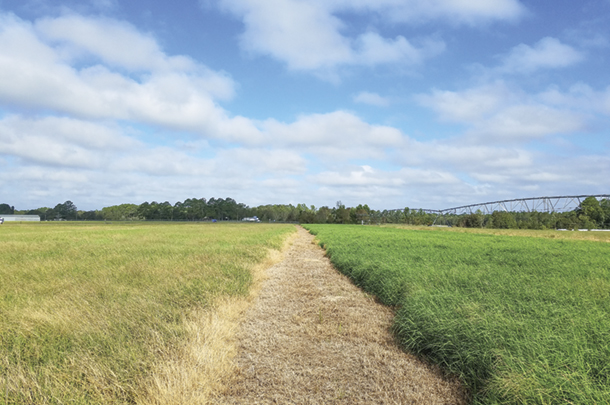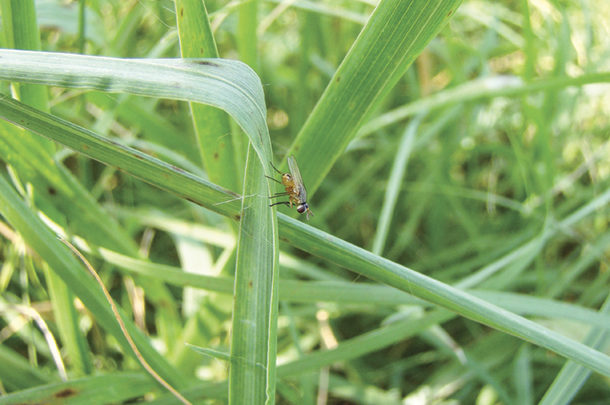The background
One summer day in 2010, University of Georgia (UGA) Extension entomologist Will Hudson got a call from county extension agent Philip Edwards in Irwin County, Georgia, about a problem in one of his hay producer’s fields.
The grower had contacted Mr. Edwards about a “frosting” of his bermudagrass. Since it had been well above freezing, they knew it wasn’t due to frost. The problem was initially thought to be a disease, and samples were sent to the UGA Plant Disease Diagnostic Lab. However, no disease was found, but instead, some maggots were observed.
There had been several other subsequent calls suggesting similar findings, like those of county agents James Jacobs and Jake Price. So it was now Hudson’s turn to determine the problem. The grass at the location was swept with a net, and multiple flying insects were found.
More grass samples were taken which contained more of the larvae of the flying insects that were swept. After an incubation period, pupae and eventually adults emerged. The adult was a fly that had not been observed in Georgia before.
 The “frosted” bermudagrass on the left is infected with bermudagrass stem maggot. Photo provided by Bill Anderson.
The “frosted” bermudagrass on the left is infected with bermudagrass stem maggot. Photo provided by Bill Anderson.
Adult samples were eventually sent to London for Dr. Adrian Pont, who is an expert on this group of flies, to examine.
Over the span of about three months, Pont determined the fly to be an invasive insect, not previously found in the southeastern U.S. The fly, identified as the bermudagrass stem maggot (Atherigona reversura Villenueve), originates in Asia and was first described in 1936. It was found in Hawaii in 1976 and California in 2009 but thought to basically affect only bermudagrass turf.
Today’s snapshot
From 2010 to the present, the invasive fly has spread to all the Southern states where bermudagrass grows, from North Carolina to Kentucky and Arkansas to eastern Texas and south to the Gulf Coast. It has caused upward of 50% yield loss in fields not controlled during certain hay clippings in mid to late summer.
Since 2010, research has been conducted by our team to determine the pest’s life cycle, economic losses due to its presence and means of controlling it through integrated pest management (IPM) strategies. Hudson, Dennis Hancock (then forage extension specialist for UGA), his then-student Lisa Baxter (now forage extension specialist), and Bill Anderson (with USDA-ARS), among others, formed a team to conduct several studies.
The team determined early on that fine-stemmed bermudagrass cultivars, such as Alicia (which is an important hay for the horse industry), were more susceptible than more coarse-stemmed cultivars. Field tests indicated that damage can cause over 50% yield loss in these cultivars if left untreated.
Bermudagrass stem maggot damage decreased relative feed quality (RFQ) of BSM-affected hay by 7% on average due to lower total digestible nutrients (TDN) and slightly lower dry matter intake (DMI). Based on such findings, the team estimated that for the roughly 300,000 acres of bermudagrass produced for hay in Georgia alone, the pest could inflict losses of up to $30 million.
Treatment options
The pest appears earlier in Southern locations, but damage moves north over the summer and reaches a peak in middle and north Georgia during the months of August and September. Producers can control the best by applying pyrethroid insecticides; however, research is continuing to determine the best timing for sprays.
Initially, producers were recommended to spray seven to 10 days after a clipping, followed by spraying again a week later. Research is currently determining whether one spray at a strategic time will be enough and whether there are other insecticides that are effective. It is only economical for hay producers to apply insecticides when the BSM population begins to build.
Producers need to be aware that overuse of one class of insecticide could eventually result in a buildup of resistance by the pest. It is also important to prevent overuse and uneconomical use of insecticides for both the profitability of hay production and the development of resistance to the pyrethroid insecticides. Thus, early detection is an essential part of the IPM strategy.
Frequent visits to the field in June and July, armed with a sweep net and knowledge of the appearance of the adults, are currently the best detection methods. However, more efficient methods of early detection are being researched.
Another important part of IPM is to develop resistant or tolerant cultivars. As mentioned previously, more coarse-stemmed material such as Tifton 85 can tolerate the pest better and result in less yield loss. But even these cultivars can endure significant yield losses without insecticide applications.
An initial screening of over 300 bermudagrass accessions was conducted by the research team at locations in Florida and Georgia beginning in 2015.
A few lines that had both good tolerance and high yields are being tested in Georgia currently. From the early results, we have found four or five very promising lines that will be increased and used for further improvements through breeding.
However, we hope to be able to release one or two of the tolerant lines in the next three to four years, after further testing at different locations and evaluation of quality.
We would like to acknowledge the Georgia Beef Commission (formally known as the Agricultural Commodity Commission for Beef) for funding much of the research done by our team.








